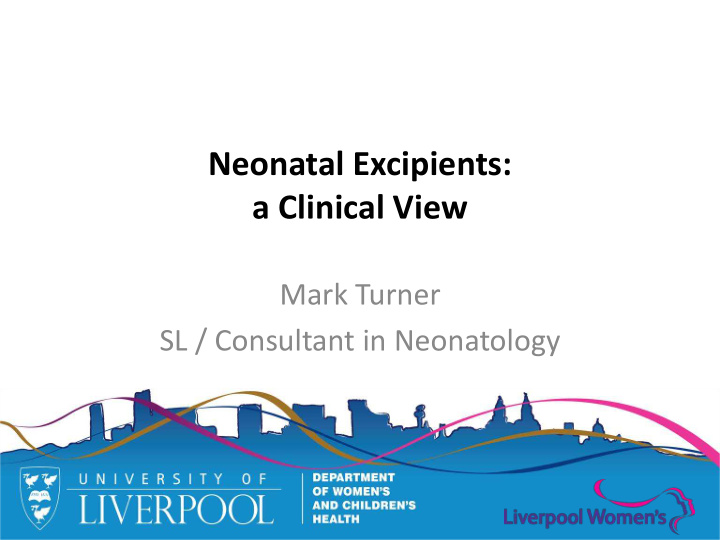



Neonatal Excipients: a Clinical View Mark Turner SL / Consultant in Neonatology
Declaration of interests • My employers have received funds for clinical studies about APIs from: Roche, Chiesi, Johnson & Johnson, Pfizer, EC FP7, NIHR, BLISS, MRC, AMR • I am part of the NEOCIRC consortium which has product under consideration by the EMA Formulations Working Group • My employers receive funds for consultancy about APIs from Chiesi, BMS, Novartis, Shire, Janssen, Grunenthal • I led ESNEE (funded by MRC) • Chair, European Network for Paediatric Research at the European Medicines Agency • Co-Director, International Neonatal Consortium
Topics • The clinical context • The therapeutic context • The clinical frustration • Clinical contributions to the solution
The clinical context • Sick preterm neonates – Inotropes for poor brain perfusion • “Healthy” preterm neonates – Vitamins • Sick term babies – Anticonvulsants
Sick preterm neonates Inotropes for poor brain perfusion • Clinical problem – During the 72 hours after birth before 27 weeks gestational age – Poor cardiac contractility – Haemodynamically significant ductus arteriosus – Rapid changes in pulmonary vascular resistance • Associated with – Mortality: 30% – 50% Neurodisability Movement – Brain injury 60% – 80% of Speech survivors Learning disability
Sick preterm neonates Inotropes for poor brain perfusion • Clinical problem – During the 72 hours after birth before 27 weeks gestational age – Poor cardiac contractility – Haemodynamically significant ductus arteriosus – Rapid changes in pulmonary vascular resistance • Associated with – Mortality: 30% – 50% Neurodisability Movement – Brain injury 60% – 80% of Speech survivors Learning disability What if medicines need excipients? How does the risk of excipient compare to the risk of the condition?
“Healthy” preterm neonates Vitamins • Clinical problem – It is very difficult to match in utero accretion of micronutrients • Associated with – Poor long-term outcomes – Numerical estimates of numbers are difficult
“Healthy” preterm neonates Vitamins • Clinical problem – It is very difficult to match in utero accretion of micronutrients • Associated with – Poor long-term outcomes – Numerical estimates of numbers are difficult What if medicines need excipients? How does the risk of excipient compare to the risk of the condition?
Sick term babies Anticonvulsants • Clinical problem – Seizures are common among babies with hypoxic-ischaemic encephalopathy / perinatal asphyxia – Also seen in other conditions: infection, metabolic, abnormal anatomy – Different epileptogenic mechanisms than other age groups • Associated with – Treatment dilemmas Neurodisability Movement – Poor outcomes 60% – 80% of Speech • Seizures survivors Learning disability • Causes of seizures
Sick term babies Anticonvulsants • Clinical problem – Seizures are common among babies with hypoxic-ischaemic encephalopathy / perinatal asphyxia – Also seen in other conditions: infection, metabolic, abnormal anatomy – Different epileptogenic mechanisms than other age groups • Associated with – Treatment dilemmas Neurodisability Movement – Poor outcomes 60% – 80% of Speech • Seizures survivors Learning disability • Causes of seizures What if medicines need excipients? How does the risk of excipient compare to the risk of the condition?
The therapeutic context My job is to make educated guesses about: • Which drug to use • Which dose to give • When to give it • When to change the dose • When to stop it
The therapeutic context My job is to make educated guesses about: • Which drug to use • Which dose to give • When to give it • When to change the dose • When to stop it …. And hope that the multiple dilutions do not lead to medication errors
Clinical Frustration • Innovative products are not available • Existing products are not risk assessed • Excipient safety – Yes or No is not always a helpful answer – We need some idea about exposure / response – We need advice about secondary prevention • Why do excipients need a special frame of reference? – When do we give excipients by themselves?
Risk Who tolerates the risk? • Regulators • Clinicians • Families – Parents – Children • Society
Proposal for a risk-based framework for safety assessment • Step 1: Define constraints • Step 2: Define goal(s) of safety assessment • Step 3: Synthesize existing knowledge • Step 4: Identify knowledge gaps • Step 5: Make a judicious plan to fill key knowledge gaps • Step 6: Conduct studies • Step 7: Synthesize new body of knowledge • Step 8: Interpret
Proposal for a risk-based framework for safety assessment • Step 1: Define constraints • Step 2: Define goal(s) of safety assessment • Step 3: Synthesize existing knowledge • Step 4: Identify knowledge gaps • Step 5: Make a judicious plan to fill key Borrow from knowledge gaps extrapolation • Step 6: Conduct studies • Step 7: Synthesize new body of knowledge • Step 8: Interpret
Define Constraints • Identify role of biological / clinical constraints – Risks of background illness – Prevention / treatment • Identify role of values
Define Constraints • Identify role of biological / clinical constraints – Risks of background illness – Prevention / treatment • Identify role of values Talk to children, young people and families
Define Constraints Talk to children, young people and families
Define Constraints • Identify role of biological / clinical constraints – Risks of background illness – Prevention / treatment • Identify role of values Beware of Talk to children, young people and parentalism families
Conclusions • How often will the drug be worse than the disease? – We accept collateral damage from the active ingredient – Why not accept excipient harms? • Clinicians can tolerate risk • Families may, or may not, tolerate risk – Ask them
Recommend
More recommend